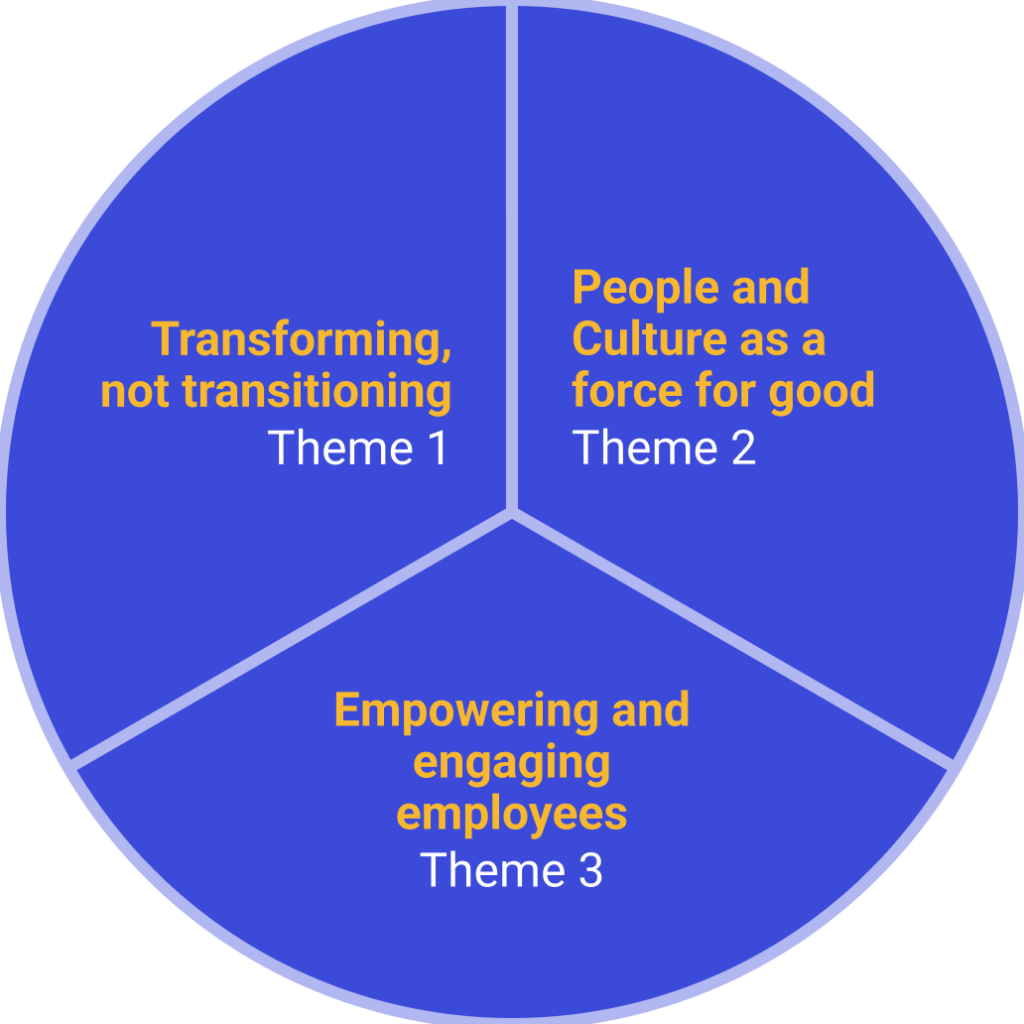These are the HR trends you need to know
The role of Human Resources (HR) professionals has changed a lot in the last few years. Not unexpectedly, seeing as virtually every part of the workplace has changed.
So, as we move into a normalization period in 2024, the question is not whether HR will continue changing. That seems like a given. Change is the only constant, after all.
The question is how HR will change.
Will the next 12 months see more monumental shifts like we’ve witnessed over the last few years, or will HR trends unfold on a smaller scale? Will professionals focus on refining their roles or adapting to new demands?
What the data says
One survey found 91% of HR leaders believe the profession has significantly changed since the COVID-19 pandemic, while only 32% see that change continuing.
We believe the number is higher in reality, partly because the same survey found that 66% of HR leaders were concerned about what the future has in store. An alarming 95% said their current role is too much work, and 81% are burnt out.
It’s possible to infer by reading between the lines that people are so eager for stability that they’re ignoring some indicators of coming change. That’s understandable, given the prevalence of exhaustion.
New challenges present new opportunities
Unfortunately for hardworking HR folks, we don’t see things settling down in the next 12 months. There will be some relief as the pace of change becomes more manageable, and some HR leaders are already far enough along the journey that they can turn their attention to clarifying and communicating an evolved remit.
Others will continue wading through unfamiliar waters. Widespread employee burnout and disengagement, the transition to remote work, and new productivity technologies are equally exciting and challenging.
The good news is you don’t need to address all these HR trends at once. There’s a way to filter, prioritize and plan so you don’t end up overwhelmed by change in 2024.
Transforming HR priorities into People and Culture strategies
One strong indicator of evolution that we’re seeing in many client organizations and partner businesses is “HR” restyling to “People and Culture”. What seems like a mere title change reflects the transformations that have rippled through the profession recently and indicates what’s still to come.
What’s the difference between HR and People and Culture?
The easiest way to understand the evolution is that HR is process-driven while People and Culture is people-focused.
HR success looks like operational excellence in a well-managed organization. People and Culture success is an environment where people at all levels of the business are aligned to the mission, vision and values.
| Human Resources | People and Culture |
| Creates policies and procedures | Works with the team to co-create guidelines |
| Supports leadership initiatives | Leads strategic projects |
| Hires the best candidate for open positions | Recruits people who will contribute to long-term organizational growth |
| Ensures the organization meets compliance requirements | Proactively analyzes and improves the employee experience |
| Manages | Leads |
| Implements disciplinary action | Works with employees to understand challenges |
| Encourages employees to participate in a defined company culture | Encourages employees to contribute to a living company culture |
Source: Time Doctor, Breaking down HR’s top priorities in 2024
In modern organizations, People and Culture is a trusted strategic advisor responsible for removing the barriers to effective work, while HR represents compliance and structure.
However, whether the changes appear in name only, or an evolved People and Culture team leaves old process-driven HR ways behind, will be decided individually by organizations and individuals.
Maintaining culture in a dynamic organization
When Gartner surveyed 500 HR leaders in 40 countries in 2023, 41% said hybrid work compromised employees’ connection to culture. Nearly half (47%) couldn’t figure out how to achieve the desired culture.
People and Culture leaders must find new strategies and approaches to maintain and strengthen organizational culture in an evolved work environment. Even if 100% of your people are on-site, employees’ and managers’ values have changed, and there’s no going back.
- Clarify what culture means: Work with leadership to define your organization’s values, mission and vision.
- Co-design new policies: New policies such as hybrid working or technology usage should set clear expectations based on consultation with employees and managers.
- Support managers to transition: Help managers who are unconvinced about hybrid work by providing training, resources and evidence.
- Enable cultural input: Create feedback systems to gather employees’ thoughts and concerns about culture, and use the feedback to improve.
- Measure cultural outputs: Metrics like absenteeism, turnover, schedule adherence, productivity and employee engagement provide a picture of cultural alignment.
Employees are more likely to disengage from company culture when they don’t connect with the organization’s purpose. Your role is to be proactive, adaptive, and innovative, using every tool at your disposal to enable authentic connection from wherever people work.
What it means for you in 2024
You don’t need a new title to become a People and Culture leader. You can start now by creating a strategic roadmap that outlines the path from process specialist to people’s champion.
Having a clear strategic vision will define the purpose of People and Culture and your contribution in the new world of work. It will help to avoid job creep, establish HR priorities, define responsibilities, and identify the missing skills and behaviors that need addressing.
It’s also likely that some of your current process responsibilities fall outside the scope of the new strategic vision. Make a plan to transition those responsibilities to other roles. Otherwise, you might end up in the cohort of critically overworked HR managers.
From there, you can start cultivating understanding among employees, managers and top-level leaders. Don’t be surprised if it takes time to get the message across. Keep working on your elevator pitch, using data to support your decisions.
Balancing purpose, profit and people
One persistent challenge that People and Culture leaders will face in 2024 is the pressure to prove and improve employee performance.
CEOs are under increasing pressure to deliver results at a time when employee and manager burnout is at historically high rates and just 33% of employees feel connected to their company’s purpose.
People want their work to mean more than a paycheck. As the people’s champion and advisor to the C-suite, this gives People and Culture managers the task of translating daily output to big-picture growth.
Done well, this link creates a through-line that benefits employees, managers and top-level leaders – and you.
- Employees feel more connected to the organization’s purpose when their hard work contributes to something greater.
- Managers make better decisions around resourcing, work priorities and daily operations.
- C-suites communicate successes and challenges with stakeholders more effectively, and grow a step closer to their workforce.
- People and Culture managers can demonstrate their impact on employee retention, productivity and profits by reporting on the right metrics.
Evolving HR into People and Culture doesn’t mean letting go of performance targets. On the contrary, high-performing People and Culture managers closely monitor relevant KPIs to understand whether people are motivated, productive and engaged.
For example, when Habitium began hiring remote workers to facilitate expansion into new markets, they quickly realized the need to provide flexible work schedules without losing sight of productivity. Rolling out Time Doctor across the organization gave managers an easy way to track individual productivity in staggered schedules, while employees gained transparency and accountability.
Employees manage their time better, managers plan more effectively, and the organization continues growing in the right direction because everyone has visibility of the bigger picture.
Purpose is greater than the individual
Environmental, social and governance (ESG) action is another trend that will continue gaining momentum in 2024 – and one that directly impacts People and Culture leaders. Stakeholders expect ESG initiatives. Employees want to work for ESG leaders. Increasingly, institutional frameworks demand ESG disclosure.
- Environmental: Sustainability results are increasingly part of the People and Culture scorecard, especially as 67% of people are more likely to accept roles in sustainable companies.
- Social: Up to 44% of employees feel alienated by their organization’s diversity and inclusion efforts, which makes authentic and inclusive action a priority for employee engagement.
- Governance: With UK, EU and US regulators rolling out ESG disclosure guidelines, People and Culture could be asked to support organizational leaders in meeting new reporting mandates.
Although ESG covers a broad spectrum, and you won’t be expected to oversee all the myriad initiatives, there’s a role for the People and Culture function in coordinating and collating the organization’s efforts.
What’s behind all this evolution? The future of work
It’s a bit of an oxymoron, but the future of work is the driving force behind the HR trends rolling out in 2024. It’s also the reason that the changes feel exponential and overwhelming. Once you understand this frame of reference, it gets easier to redefine the strategic vision for an evolved People and Culture team and engage internal stakeholders effectively.
Of course, the “future of work” means different things to different organizations. For some, it’s embracing generative and analytical AI to streamline processes and tasks. For others, it’s a transition to hybrid, remote or asynchronous work. Some organizations see the future in flexible scheduling, while others see it represented in personalized customer experiences.
Dig deep enough and you’ll discover the gooey core common to all modernizing expectations: human centricity.
Employees want flexible schedules and remote work so that work adapts to life, not the other way around. Customers want personalized experiences to feel valued as individuals rather than dollar signs. Managers want guidance on priorities so they can work to their strengths.
For People and Culture leaders, evolving out of process mindsets means positioning people at the center of every decision. At the risk of introducing another oxymoron, the way to do that is with data.
For employees, workday data offers transparency to help them understand their contributions while enabling them to self-manage a flexible schedule. For managers, having oversight of employee well-being, individual and team productivity, and real-time employee activity means better decision-making and more individual leadership decisions.
Workday data even benefits customers, because it’s been shown to boost employee engagement and increase customer satisfaction.
The bottom line is there’s a lot of work to do in 2024. You can only hope to be effective if you understand how tomorrow’s efforts help you get where you’re going long-term.
Get deeper insight into HR trends in 2024
Admittedly, we’ve only scratched the surface of the evolution from HR to People and Culture, and the strategies emerging leaders use to transform their organizations. There is a lot more to unpack in the coming weeks and months.

Our new guide, Breaking down HR’s top priorities in 2024, takes a deeper dive into the areas you need to focus on in the next 12 months. We looked across the landscape of HR trends to identify nine People and Culture priorities grouped into three themes.

The themes help to focus the broad strokes of work culture evolution as HR’s priorities rise and fall in importance from one organization to the next. If you want to stay ahead of the curve and ensure your organization is successful in the future of work, then this guide will be a helpful resource.
Time Doctor enables productivity with purpose
As HR evolves into People and Culture, and office work evolves into hybrid work, Time Doctor is helping modern organizations access and act on workday insights. Our employee-friendly features bring together employee well-being and productivity, giving leaders and employees the tools to get better by the minute.
Discover the tools you can use to conquer 2024, or get in touch to speak with a Time Doctor productivity specialist about your unique challenges.

Liam Martin is a serial entrepreneur, co-founder of Time Doctor, Staff.com, and the Running Remote Conference, and author of the Wall Street Journal bestseller, “Running Remote.” He advocates for remote work and helps businesses optimize their remote teams.


